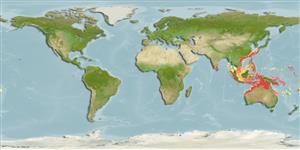>
Acropomatiformes (Oceanic basses) >
Glaucosomatidae (Pearl perches)
Etymology: Glaucosoma: Greek, glaukos = white, shining + Greek, soma = body (Ref. 45335).
Eponymy: Dr Heinrich Bürger (1804/06*-1858) was a German physicist and biologist employed by the Dutch government. [...] (Ref. 128868), visit book page.
More on author: Richardson.
Environment: milieu / climate zone / depth range / distribution range
Ecologia
marino benthopelagico; distribuzione batimetrica ? - 146 m (Ref. 58018). Tropical; 32°N - 25°S
Western Pacific: Western Australia from Koks Island, Shark Bay northwards to Cape Talbot; Japan from Kochi Prefecture, Ryukyu Islands southwards and along the north China coast to Taiwan and Viet Nam.
Size / Peso / Age
Maturity: Lm ? range ? - ? cm
Max length : 55.0 cm TL maschio/sesso non determinato; (Ref. 45251); common length : 35.0 cm TL maschio/sesso non determinato; (Ref. 27621); peso massimo pubblicato: 2.5 kg (Ref. 3132)
Spine dorsali (totale) : 8; Raggi dorsali molli (totale) : 11; Spine anali: 3; Raggi anali molli: 9. One dark vertical band through eye which may disappear with an increase in size; 11 dorsal fin rays and 9 anal fin rays. Supraclavicle not developed into a bony shield. Peritoneum and gill rakers black; lateral line with 49 to 51 pored scales; juveniles with narrow horizontal bands narrower than interspaces.
Inhabit trawling grounds. Found in moderate depths on the continental shelf, particularly close to reefs or rough bottoms. Carnivorous. Marketed fresh and salted (Ref. 27621).
Life cycle and mating behavior
Maturità | Riproduzione | Deposizione | Uova | Fecundity | Larve
McKay, R.J., 1997. FAO Species Catalogue. Vol. 17. Pearl perches of the world (family Glaucosomatidae). An annotated and illustrated catalogue of the pearl peches known to date. FAO Fish. Synop. 125(17):26p. Rome: FAO. (Ref. 27621)
IUCN Red List Status (Ref. 130435: Version 2024-2)
Threat to humans
Harmless
Human uses
Pesca: scarso interesse commerciale
Strumenti
Special reports
Download XML
Fonti Internet
Estimates based on models
Preferred temperature (Ref.
123201): 24.2 - 28.8, mean 27.6 °C (based on 776 cells).
Phylogenetic diversity index (Ref.
82804): PD
50 = 0.6250 [Uniqueness, from 0.5 = low to 2.0 = high].
Bayesian length-weight: a=0.02399 (0.01809 - 0.03181), b=2.89 (2.80 - 2.98), in cm total length, based on LWR estimates for this species (Ref.
93245).
Trophic level (Ref.
69278): 4.2 ±0.5 se; based on size and trophs of closest relatives
Resilienza (Ref.
120179): Basso, tempo minimo di raddoppiamento della popolazione 4.5 - 14 anni (tmax=26; k=0.13).
Fishing Vulnerability (Ref.
59153): High vulnerability (57 of 100).
